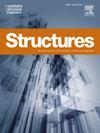Evaluation of the effects of grouting rate and flanges on the seismic performance of mortarless mortise-and-tenon masonry walls
IF 3.9
2区 工程技术
Q1 ENGINEERING, CIVIL
引用次数: 0
Abstract
Mortarless masonry structures (MMS) are increasingly becoming the preferred solution for a new generation of masonry structures due to high construction efficiency and low demand for skilled labor. As an effective method to enhance the lateral load resistance of MMS, grouted reinforcement has received limited research, and the effect of partially grouted reinforcement has not been considered. Against this background, combining the characteristics of interlocking masonry units and grouting reinforcement, this paper designed a grouted mortarless mortise-and-tenon masonry wall (MMTW). At the same time, considering the effects of grouting rate and flange, three specimens were fabricated for low cycle reciprocating loading tests, and effects of different structures on the seismic performance of MMTWs were evaluated. Furthermore, the results were compared with traditional mortar masonry walls to assess the influence of mortarless connection methods on the performance of MMTW. The results indicated that with the increase of grouting rate, the bearing capacity of wall MW2 increased by 69.47 % compared with that of wall MW1, and the effect of mortar deficiency on the damage behavior of MMTWs gradually decreased. In partially grouted MMTWs, both the mortise-and-tenon building blocks and the core columns interacted and were jointly stressed, participating in the stress system of MMTW in stages. Compared with wall MW1, the average loads and displacements at each characteristic point of wall MW3 were reduced by about 9.5 % and 7.5 %, respectively. The presence of the flanges did not significantly improve the performance of wall MW3, primarily due to the uneven distribution of the overall stiffness of wall MW3, which caused local damage to the wall. In addition, compared with mortar mortise-and-tenon masonry walls, the bearing capacity of MMTWs was reduced, but their deformation capacity and stiffness degradation rate were improved to varying degrees. The findings of this study contribute to a more comprehensive understanding of the performance of MMTW with varying structural configurations under lateral loads, thereby providing guidance for relevant application and development.
求助全文
约1分钟内获得全文
求助全文
来源期刊

Structures
Engineering-Architecture
CiteScore
5.70
自引率
17.10%
发文量
1187
期刊介绍:
Structures aims to publish internationally-leading research across the full breadth of structural engineering. Papers for Structures are particularly welcome in which high-quality research will benefit from wide readership of academics and practitioners such that not only high citation rates but also tangible industrial-related pathways to impact are achieved.
 求助内容:
求助内容: 应助结果提醒方式:
应助结果提醒方式:


